|
|
 |
| On 11 th Nov. 2005, the 78th Safety Caravan visited was held at to Tokai Power Station, located in Tokai-mura, Ibaraki Prefecture. |
|
Safety Presentation |
55 persons, including the employees of Tokai Power Station, JAPC and cooperating companies, attended the Safety Presentation.
At the beginning of the presentation,
Superintendent of the Tokai Power Station, Masao Aoyagi, addressed the audience saying, "For our company which is engaged solely in the nuclear power generation business, assuring nuclear power safety is indispensable from a business aspect as well. There are many issues at Tokai Power Station that have been brought up in regards to safety culture and I hope this safety caravan will improve our safety culture."
|
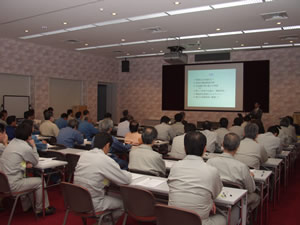 |
|
Safety Presentation
|
After the opening statement, the director of the Nuclear Safety Network Division (NS net) of the Japan Nuclear Technology Institute (JANTI) introduced the activity policies of the JANTI and gave an update of the NS net division's activities. After that CEO and President of the Japan Functional Safety Laboratory, Ritsuo Yoshioka "gave a speech entitled, "Why do Accidents Happen? The Framework of safety in Advanced countries that have learned from Accidents" |
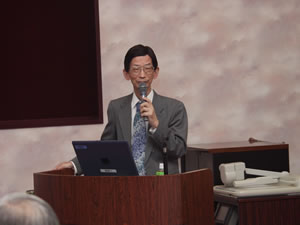
|
|
Mr.Yoshioka
|
During the lecture, Mr.Yoshioka stated:
 In regards to accidents, there is no easy way to achieve absolute safety immediately. You have to first understand why the accident occurred. You have to find the best way to prevent the root cause. About 70 to 80% of accidents are caused by human factors. But, human factors are not the root cause of accidents. We have to know the root causes, which are made up of the following three elements: In regards to accidents, there is no easy way to achieve absolute safety immediately. You have to first understand why the accident occurred. You have to find the best way to prevent the root cause. About 70 to 80% of accidents are caused by human factors. But, human factors are not the root cause of accidents. We have to know the root causes, which are made up of the following three elements:
• A lack of safety culture (Overconfidence and self-satisfaction are the leading factors of this)
• A lack of organizational structure
• A lack of technology activities
 Fundamentally, it is important to balance the safety with the economy. It is often said that, "a company with a lot of trouble has a lot of accidents," and there is actually a strong correlation between the two. Fundamentally, it is important to balance the safety with the economy. It is often said that, "a company with a lot of trouble has a lot of accidents," and there is actually a strong correlation between the two.
 In analyzing the root cause of an accident you can separate it into "direct cause" and "root cause". Especially in Japan, there is a tendency to consider the direct cause as the root cause. Furthermore, in Japan we are not accustomed to consider the risk. In analyzing the root cause of an accident you can separate it into "direct cause" and "root cause". Especially in Japan, there is a tendency to consider the direct cause as the root cause. Furthermore, in Japan we are not accustomed to consider the risk.
 This new type of safety organization called, "functional safety" is comprised of individual competency (qualifications, behaviors, characteristics) This new type of safety organization called, "functional safety" is comprised of individual competency (qualifications, behaviors, characteristics) evaluation of the organizations functional safety potential evaluation of the organizations functional safety potential product certification, and you need all three to be truly safe. product certification, and you need all three to be truly safe.
 Competency policies are established in each field. Especially in the safety field, what kind of behaviors/characteristics are required for achieving safety are clearly shown in the Functional Safety. Competency policies are established in each field. Especially in the safety field, what kind of behaviors/characteristics are required for achieving safety are clearly shown in the Functional Safety.
The post-lecture survey revealed the following:
|
Some comments on the questionnaire passed out after the speech noted
 Looking at accidents that occur on a daily basis, I became quite aware of just how accidents could occur at every company. I have a tendency to look only at accidents that occur in the nuclear power industry, but I reaffirmed that there are things on the soft/hard side of accidents at other companies that we can put to use at our company. Looking at accidents that occur on a daily basis, I became quite aware of just how accidents could occur at every company. I have a tendency to look only at accidents that occur in the nuclear power industry, but I reaffirmed that there are things on the soft/hard side of accidents at other companies that we can put to use at our company.
 It was a very easily understood presentation that made me see the light. In the future I will be able to see past examples from this enlightened standpoint before accidents happen in the future. IEC61508 was a little difficult to understand, so I will study it later while reviewing the materials It was a very easily understood presentation that made me see the light. In the future I will be able to see past examples from this enlightened standpoint before accidents happen in the future. IEC61508 was a little difficult to understand, so I will study it later while reviewing the materials
 I was able to understand that overconfidence and self-satisfaction are large factors that contribute to accidents. The fact that safety culture is quite a difficult issue was really hit home. I was able to understand that overconfidence and self-satisfaction are large factors that contribute to accidents. The fact that safety culture is quite a difficult issue was really hit home.
 The point that "Reliability and safety are different matters" was very interesting. I hope to reflect that point in our work operations. The point that "Reliability and safety are different matters" was very interesting. I hope to reflect that point in our work operations.
|
Safety information exchange session |
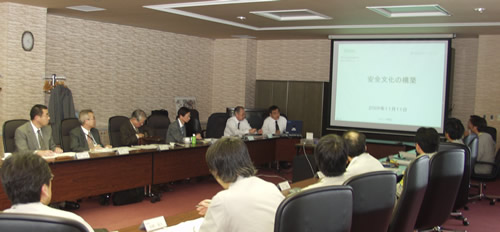 |
|
Safety information exchange session
|
The NS net Division gave a presentation on safety culture principles, the lessons learned from the Mihama accident and creating safety climate entitled "Enhancing Safety Culture". It was also explained that there is a topic for evaluation of the safety culture by regulator. In continuation, Yoshiharu Yamaguchi, sub-manager of JAPC's Tokai Power Station Plant Mgmt. Group, gave a presentation entitled "Safety Improvements and Quality Assurance Activities at Tokai Power Station" in which he introduced how a meister system and quality goals were established and what is being done to achieve those goals. In addition, in regards to fostering safety culture, it was also explained that, as a result of a survey designed to measure organizational factor of safety culture, five problems, such as communication, etc., were pointed out and measures to fix those problems are being designed, plus, in order to achieve stable and safe operation, awareness improvement activities that utilize performance indicators are being implemented.
|
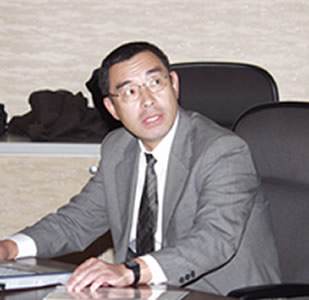 Mr.Umeda
Mr.Umeda |
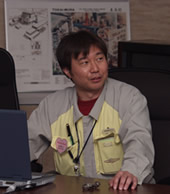 Mr.Yamaguchi
Mr.Yamaguchi |
|
|
Furthermore, Masayuki Umeda, assistant manager of Fuel Mgmt. in the HTTR Reactor Engineering Section at the Japan Atomic Energy Agency explained about improvement activity in safe consciousness for the staff using Unusual Report (including proposal to make better) was used with the High Temperature Engineering Test Reactor (HTTR) whereby anyone could make a point of something they noticed and explained their endeavors to make improvements based on it. |
|
( is JAPC, is JAPC,  is instructor and is instructor and  is NS net Division) is NS net Division)
 How do you supervise quality assurance from a third-party perspective? How do you supervise quality assurance from a third-party perspective?
 It is done by the Quality Audit & Business Practice Examination Dept., which is an independent department. It is done by the Quality Audit & Business Practice Examination Dept., which is an independent department.
 I don ' t understand how the configuration elements are put togetherin the safety culture explanation. I don ' t understand how the configuration elements are put togetherin the safety culture explanation.
 Of course there are policy level and organizational measures being implemented. But, they are not being implemented according to level. Rather, whereas management is implementing these measures, I think the problem is that the younger people aren't taking that to heart. Of course there are policy level and organizational measures being implemented. But, they are not being implemented according to level. Rather, whereas management is implementing these measures, I think the problem is that the younger people aren't taking that to heart.
 We circulate a non-conformity record within the power station. Originally it focused on non-conformity evaluation of sub-contractors, but now we record them as our own problems. So, this was a kind of avoidance to writing done our own mistakes. Did you not have the same problem at JAERI at the moment? We circulate a non-conformity record within the power station. Originally it focused on non-conformity evaluation of sub-contractors, but now we record them as our own problems. So, this was a kind of avoidance to writing done our own mistakes. Did you not have the same problem at JAERI at the moment?
 With the HTTR, since we were required to perform system function/whole system function tests after component function tests, criticality tests and power-up tests on our own, each staff brought up different issues. We had no one who had avoidance to recording down anything. Actually, since we had a lot of beginners who had not had much experience operating a nuclear reactor, we started from the standpoint of what can we do to improve our consciousness. With the HTTR, since we were required to perform system function/whole system function tests after component function tests, criticality tests and power-up tests on our own, each staff brought up different issues. We had no one who had avoidance to recording down anything. Actually, since we had a lot of beginners who had not had much experience operating a nuclear reactor, we started from the standpoint of what can we do to improve our consciousness.
 Quality assurance is built into safety regulations, which have become a regulatory tool. I don ' t think it is related to safety culture fostering. Rather, the current safety regulations serve to hinder safety culture. Quality assurance is built into safety regulations, which have become a regulatory tool. I don ' t think it is related to safety culture fostering. Rather, the current safety regulations serve to hinder safety culture.
 Being bogged down by safety regulations will prevent good results. Director Ishikawa thinks that regulations should be on par with the US ROP (Reactor Observation Process). I think safety culture is independent action by the business operator. Being bogged down by safety regulations will prevent good results. Director Ishikawa thinks that regulations should be on par with the US ROP (Reactor Observation Process). I think safety culture is independent action by the business operator.
 You have to use your imagination and manage risk. You can get to the root of the problem through the lateral dissemination of information. I think it's satisfactory if that leads to prevention as well as the prevention of even larger problems. |
|
|







